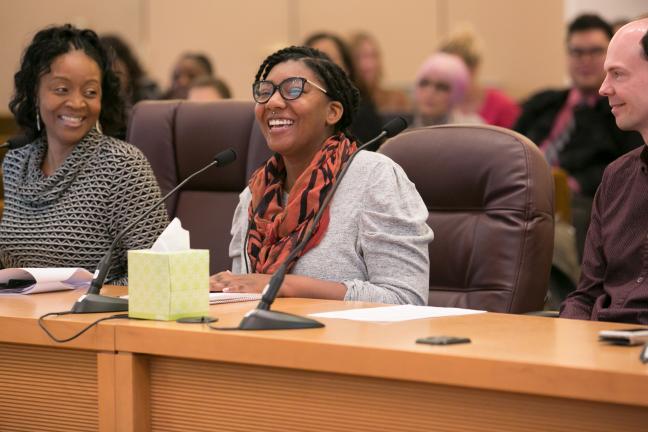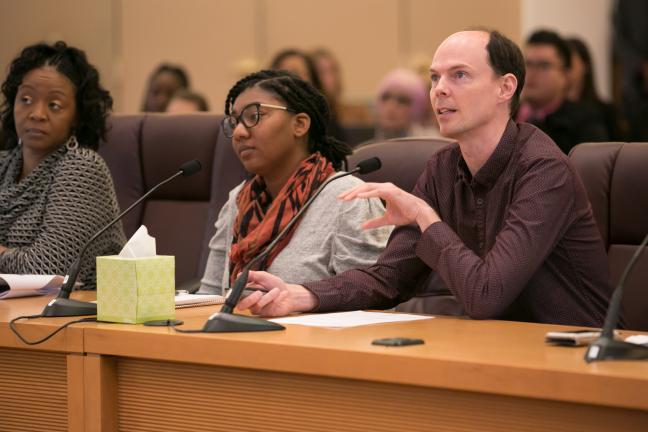When Multnomah County Public Health won a $3-million grant in 2014 to improve nutrition and reduce tobacco use for African American residents,
As Public Health Week unfolds in events across the nation, local partners of the Racial and Ethnic Approaches to Community Health (REACH) grant funded by the Centers for Disease Control and Prevention, summarized their work to the Multnomah County Board of Commissioners
Health educators have worked with churches and mosques to craft culturally-specific solutions to
Program staff partnered with the Oregon State University Extension Services and child care centers to teach kids how to assemble a salad, chop veggies and cut fruit. Care providers swapped candy rewards for fruits and vegetables while health educators adapted classroom lessons and reading lists to include characters and scenarios that reflected children of color.
They helped convenience stores deliver fresh produce, and created culturally-specific health signage and messages.
“A lot of what we’re doing is building capacity,” Nikoyia Phillips, a health educator with REACH, told commissioners Tuesday. “Today we’re really focused on sustaining the areas where we’ve worked. They are really hungry for resources, culturally-specific resources.”
The federal REACH program began in 1999 as a way to measure health disparities among communities of color. In 2014, the CDC awarded agencies more than $100 million to explore culturally-specific initiatives that would narrow those divides. Grant partners in Multnomah County have included the African American Health Coalition, Ecumenical Ministries of Oregon, Highland Haven, Urban League of Portland, Upstream Public Health, Oregon Public Health Institute, IRCO/Africa House and the City of Gresham.
The partners had come together nearly a decade earlier, in 2009, as a coalition called ACHIEVE to create a vision and strategies to reduce health disparities.
“We knew that to attack chronic disease disparities in the county we had to focus on the African American community,” said Public Health Director Rachael Banks.
ACHIEVE members wanted the county to commit to a sustained partnership, rather than come and go as funding-permitted. Banks’ program agreed, applying for and winning more than $10 million in health grants over the following years that allowed the coalition to grow.
“We promised we would continue the work, whether there was grant money for it or not,” Banks said following Tuesday’s presentation. “We’ve stayed true to our commitments. When we got grant funds, they went back out to community partners.”
REACH program manager Tameka Brazile said she’s particularly proud of the moves their partners at the City of Gresham have made to include underrepresented voices in transportation planning.
“When you engage people from the beginning of the process, they feel more invested and are more willing to be part of the process,” Brazile said. “It gives people a sense of say-so in their environment and they’re able to prioritize what’s important to them."
REACH helped the Gresham Redevelopment Commission devise a recruitment strategy for food vendors who will provide fresh, health and culturally-specific options in the Rockwood Rising development, slated to break ground this year. Commissioner Lori Stegmann, who lives in Gresham, said she’s excited about the project. “It’s a food desert,” she said. “People in Rockwood get on the light rail to go to the Gateway WinCo to get food. That’s crazy.”
Jay Higgins, a transportation planner with the City of Gresham, told commissioners the city used a portion of the REACH grant to develop a more walkable and bike-friendly community in low-income neighborhoods with few sidewalks, crosswalks or bikeable roads. They developed the plan after hiring six community members who walked neighborhoods, surveyed residents and organized events.
“REACH has had a huge impact,” he said Tuesday. “We really gathered a lot of robust information. It helped the city build relationships with community organizations and it helped us consider equity impacts.”
Board members thanked the presenters for sharing the work, and said they hoped it could continue even after grant sunsets this fall.
“I really enjoy hearing about ways that we’re continuing to get to communities we need to reach and not using traditional methods that leave our families and people behind,” said Chair Deborah Kafoury. “We’re going to be able to use these strategies in other ways.”
Public Health Director Banks said the REACH grant created a framework that her department can build on.
“It’s a grant, but it’s also an approach to address disparities. It’s an investment and a sustained commitment to the African American community,” she said. “Were now using the REACH model, and that’s going to continue. The grant is ending, but the model will continue.”


